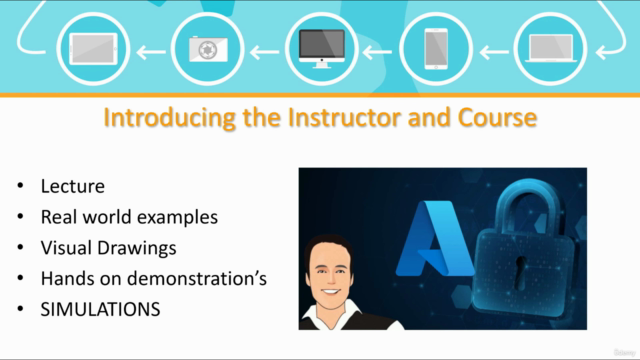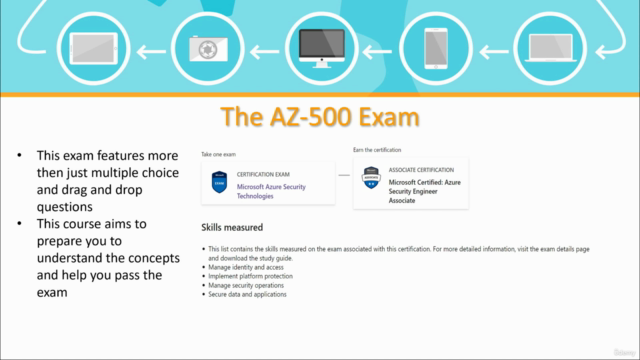AZ-500 Microsoft Azure Security Technologies with SIMS

Why take this course?
based on the topics you've outlined, it seems like you're looking to cover a comprehensive set of security and compliance controls within Microsoft Azure. To achieve this, you can follow these steps:
-
Understand Azure Role-Based Access Control (RBAC):
- Begin by familiarizing yourself with the different levels of access control in Azure (management groups, subscriptions, resource groups, and resources).
- Learn how to interpret built-in roles and understand how to assign them within Azure Active Directory (Azure AD), which is part of Microsoft Entra.
-
Implement Advanced Network Security:
- Secure hybrid network connectivity.
- Set up virtual networks and subnets, ensuring they are securely configured.
- Use Azure Firewall to protect your virtual network traffic.
- Configure Azure Firewall Manager for centrally managed security policies.
- Understand the differences between Azure Application Gateway, Azure Front Door, and Web Application Firewall (WAF).
- Implement these services to protect your applications and direct traffic securely.
- Use Private Endpoints and Service Endpoints to enhance security by keeping traffic within Azure's network where possible.
- Configure DDoS Protection to mitigate distributed denial-of-service attacks.
-
Configure Advanced Security for Compute:
- Secure your virtual machines (VMs) with Endpoint Protection.
- Implement security updates and patches for VMs to protect against vulnerabilities.
- Configure security for container services, manage access to Azure Container Registry, and secure serverless compute.
- Harden App Service configurations by managing access, enabling encryption at rest, and in transit.
-
Centralized Policy Management:
- Create custom security policies using Azure Policy to enforce compliance across your resources.
- Organize policies into initiatives for better management.
-
Configure and Manage Threat Protection:
- Understand Microsoft Defender for Cloud and how it can be used to configure threat protection settings.
- Configure Microsoft Defender for Servers to protect virtual machines hosted on Azure.
- Use the platform to evaluate your environment for vulnerabilities.
-
Security Monitoring Solutions:
- Set up alert rules in Azure Monitor to notify you of critical events.
- Configure diagnostic logging and log retention policies.
- Implement Microsoft Sentinel for advanced threat detection, investigation, and response across your entire environment.
-
Configure Security for Storage:
- Create a storage account and configure access control settings, such as Access Control Lists (ACLs) and keys.
- Configure Azure Files with identity-based authentication for SMB access.
- Set up delegated access for fine-grained control.
-
Configure Security for Data:
- Enable SQL Databases or Servers, configure firewall settings, and set up Azure AD integration for authentication.
- Implement database auditing to monitor activities.
- Use dynamic masking to protect sensitive data.
- Enforce encryption for databases, such as Azure SQL Database.
- Network isolate data solutions like Synapse Analytics and Cosmos DB to enhance security.
-
Configure Azure Key Vault:
- Create and manage a Key Vault to securely store secrets, keys, and certificates.
- Understand when to use a dedicated Hardware Security Module (HSM).
- Manage access control and configure key rotation for enhanced security practices.
- Implement backup and recovery procedures for your stored data in Key Vault.
-
Finishing Up:
- After implementing these controls, regularly review and update your configurations to adapt to new threats and comply with evolving compliance requirements.
- Consider obtaining relevant certifications (e.g., Microsoft Certified: Azure Security Technologies Associate) to validate your expertise.
- Stay informed about the latest security best practices and updates from Microsoft regarding Azure services and features.
Remember that security is an ongoing process, not a one-time setup. Regularly review and update your configurations, stay educated on the latest threats and compliance requirements, and always follow the principle of least privilege when granting permissions to users and services.
Course Gallery




Loading charts...